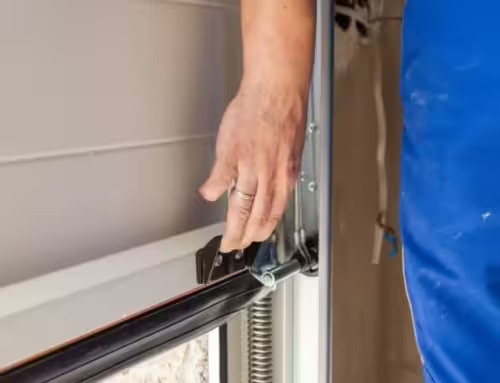- Sectional Garage Doors
- Style: Made up of panel sections connected with hinges.
- History: Gained popularity in the mid-20th century as homes in suburbs became more common.
- Function: Operate by rolling up vertically along tracks to the ceiling. Each panel has its own connection to the track, which allows the door to bend as it rolls up.
- Roll-Up Garage Doors
- Style: Comprised of narrow horizontal slats.
- History: Originated from industrial settings and adapted for residential use.
- Function: Rolls up into a coil above the opening, often used in commercial applications due to their durability and security.
- Slide to the Side Garage Doors
- Style: Operate by sliding to one side of the garage and sit parallel to the wall.
- History: One of the earliest operating styles, preceding overhead doors.
- Function: Ride on lower trolleys that are flexible enough to work with slight slopes in the floor or ceiling.
- Side-Hinged Garage Doors
- Style: Open and close from a hinged frame on either side of the opening.
- History: Traditional style, reminiscent of old carriage house doors.
- Function: Operate like large barn doors, swinging open and closed on hinges. Often used in garages with limited headroom.
- Tilt-Up/Up-and-Over Canopy Garage Doors
- Style: Single solid piece that tilts up into the garage.
- History: Popular in mid-20th century, particularly in the 1950s and 60s.
- Function: Pivoting mechanism allows the door to tilt up and back into the garage ceiling. The canopy door protrudes out of the garage when open
- Tilt-Up/Up-and-Over Retractable Garage Doors
- Style: Single solid piece that lifts up and retracts fully into the garage.
- History: Evolved from the canopy style to provide a cleaner, more efficient opening.
- Function: Operates similarly to the canopy door but fully retracts into the garage, requiring more space but providing a more streamlined look when open.
- Side-Sliding Sectional Doors
- Style: Similar to sectional doors but slide to the side instead of up.
- History: Developed to provide an alternative for garages with limited headroom.
- Function: Operates by sliding horizontally along the garage wall, ideal for garages with low or obstructed ceilings.
- Glass Panel Garage Doors
- Style: Modern and sleek, often used for aesthetic appeal.
- History: Became popular in the late 20th century with the rise of contemporary architecture.
- Function: Operate similarly to sectional or tilt-up doors, made primarily of glass panels framed in aluminum or steel.
Detailed Functionality and Features
Sectional Garage Doors:
- Tracks and Rollers: Each panel has wheels that ride on tracks, allowing smooth movement.
- Safety: Often equipped with safety features like pinch-resistant panels and tamper-resistant brackets.
Roll-Up Garage Doors:
- Durability: Made of steel or aluminum, designed for heavy use.
- Security: Provide high security, commonly used in commercial settings.
Slide to the Side Garage Doors:
- Space Utilization: Great for garages with limited overhead space.
- Ease of Use: Can be automated for convenience.
Side-Hinged Garage Doors:
- Classic Appeal: Often chosen for their traditional look.
- Customization: Can be customized with various materials like wood or steel.
Tilt-Up/Up-and-Over Canopy and Retractable Garage Doors:
- Mechanism: Uses pivot arms and springs to lift the door.
- Space Requirement: Canopy doors need less ceiling space, while retractable doors need more.
Side-Sliding Sectional Doors:
- Flexibility: Can accommodate unique garage layouts.
- Smooth Operation: Uses a motor and track system for easy sliding.
Glass Panel Garage Doors:
- Aesthetics: Enhances the visual appeal of modern homes.
- Natural Light: Allows natural light to enter the garage while maintaining privacy with frosted or tinted glass options.
Each type of garage door offers unique benefits and suits different architectural styles and functional needs. The choice of door often depends on the garage’s structural constraints, aesthetic preferences, and the homeowner’s requirements for security and convenience.






